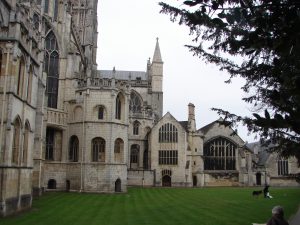 The medieval church plays a major role in each of the Lady Apollonia stories because of its wealth and omnipresence in 14th century life in England. Readers will learn that the parish church in the village of Aust was a Prebend or ecclesiastical living held by John Wycliffe early in his career. Thought to have been built on pagan ground, the church was not dedicated to a saint and had no name in the 14th century. It survives today as the Chapelry of Saint John. Aust parish church appears in the first book of the series, Effigy of the Cloven Hoof, and will be important in the seventh book.
The medieval church plays a major role in each of the Lady Apollonia stories because of its wealth and omnipresence in 14th century life in England. Readers will learn that the parish church in the village of Aust was a Prebend or ecclesiastical living held by John Wycliffe early in his career. Thought to have been built on pagan ground, the church was not dedicated to a saint and had no name in the 14th century. It survives today as the Chapelry of Saint John. Aust parish church appears in the first book of the series, Effigy of the Cloven Hoof, and will be important in the seventh book.
The Cathedral Church of Saint Peter in Exeter had been built by 1380 and plays an important role in the second book, Plague of a Green Man. There are other remnants of medieval buildings in Exeter such as Saint Nicholas Priory and Polsloe Priory, both of which are referred to in the story.
The church of the Abbey of Saint Mary in Gloucester did not become a cathedral until the time of Henry VIII’s Dissolution of the Monasteries and is important in the third book, Memento Mori, set in 1392. The picture shown above shows the north side of the church with the chapter house on the right. Another living Gothic church in that story is Saint Mary de Crypt which continues its ministry today.
Cirencester Abbey in book four, Templar’s Prophecy, was destroyed at the time of the Dissolution as was Glastonbury Abbey of book five, Joseph of Arimathea’s Treasure. There are no ruins left above ground for two of the Cirencester churches in the story of Templar’s Prophecy, but the parish church, though altered after 1395, still stands. Only ruins remain of Glastonbury Abbey’s great church which is critical to the story set in 1397, but Saint John’s Parish Church, which also plays a role in the story, is still in use today.
Finally, the present cathedral in Worcester is important to the story of book six, King Richard’s Sword. It was a monastic cathedral in the Lady Apollonia’s 14th century, an important priory church.
Tags: Chaucer's England, historical fiction, medieval mysteries